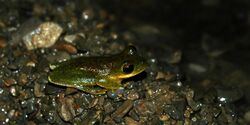Biology:Hylinae
| Hylinae | |
|---|---|

| |
| Hyla arborea | |
| Scientific classification | |
| Domain: | Eukaryota |
| Kingdom: | Animalia |
| Phylum: | Chordata |
| Class: | Amphibia |
| Order: | Anura |
| Family: | Hylidae |
| Subfamily: | Hylinae Rafinesque, 1815 |
| Type genus | |
| Hylaria Rafinesque, 1814 (an unjustified emendation of Hyla Laurenti, 1768)
| |
| Genera | |
|
18 genera (but see text) | |
Hylinae is a large subfamily of "tree frogs", family Hylidae.[1][2][3]
Classification
The contents of this subfamily vary substantially according to the source. The Amphibian Species of the World follows the revision by Duellman and colleagues from 2016 based on molecular data[4] and delimits the subfamily more narrowly than before, treating parts of former Hylinae as their own subfamilies.[1] Following this classification, there were 18 genera totaling 174 species in the end of 2020. They are found North, Central, and the northmost South America, much of temperate Eurasia, Japan, and extreme northern Africa,[5] however, only Hyla is found outside the Americas.[2] The Wikipedia is following this classification.
The AmphibiaWeb[2] follows an older classification defining Hylinae more broadly, with several hundred species.[3][6] At the end of 2020, the AmphibiaWeb lists 42 genera totaling 737 species.[2]
Amphibian Species of the World
At the end of 2020, the Amphibian Species of the World includes the following 18 genera:[5]
- Rheohyla Faivovich, Pereyra, Luna, Hertz, Blotto, Vásquez-Almazán, McCranie, Sánchez, Baêta, Araujo-Vieira, Köhler, Kubicki, Campbell, Frost, Wheeler, and Haddad, 2018
- Bromeliohyla Faivovich, Haddad, Garcia, Frost, Campbell, and Wheeler, 2005
- Charadrahyla Faivovich, Haddad, Garcia, Frost, Campbell, and Wheeler, 2005
- Dryophytes Fitzinger, 1843
- Campbell and Smith, 1992 Faivovich, Haddad, Garcia, Frost, Campbell, and Wheeler, 2005
- Brocchi, 1879 Laurenti, 1768
- Faivovich, Haddad, Garcia, Frost, Campbell, and Wheeler, 2005 Taylor, 1944
- Duellman, Marion, and Hedges, 2016 Cope, 1865
- Tlalocohyla Isthmohyla
- Plectrohyla Quilticohyla
- Sarcohyla Faivovich, Haddad, Garcia, Frost, Campbell, and Wheeler, 2005
- Duellmanohyla Ecnomiohyla
- Exerodonta Hyla
- Faivovich, Haddad, Garcia, Frost, Campbell, and Wheeler, 2005 Brocchi, 1877
- Faivovich, Pereyra, Luna, Hertz, Blotto, Vásquez-Almazán, McCranie, Sánchez, Baêta, Araujo-Vieira, Köhler, Kubicki, Campbell, Frost, Wheeler, and Haddad, 2018 Duellman, Marion, and Hedges, 2016
- Cope, 1866 Triprion
- Atlantihyla Megastomatohyla
- Ptychohyla Smilisca
AmphibiaWeb
At the end of 2020, the AmphibiaWeb includes the following 42 genera:[2]
Characteristics
Hylinae are largely arboreal frogs, although Smilisca and Triprion are burrowers. Eggs are deposited in water and the tadpoles are aquatic.[3]
References
- ↑ 1.0 1.1 Frost, Darrel R. (2020). "Hylidae Rafinesque, 1815". AmphibiaWeb. University of California, Berkeley. https://amphibiansoftheworld.amnh.org/Amphibia/Anura/Hylidae.
- ↑ 2.0 2.1 2.2 2.3 2.4 "Hylidae". AmphibiaWeb. University of California, Berkeley. 2020. http://amphibiaweb.org/lists/Hylidae.shtml.
- ↑ 3.0 3.1 3.2 Vitt, Laurie J.; Caldwell, Janalee P. (2014). Herpetology: An Introductory Biology of Amphibians and Reptiles (4th ed.). Academic Press. p. 166.
- ↑ Duellman, William E.; Marion, Angela B.; Hedges, S. Blair (2016). "Phylogenetics, classification, and biogeography of the treefrogs (Amphibia: Anura: Arboranae)". Zootaxa 4104 (1): 1–109. doi:10.11646/zootaxa.4104.1.1. PMID 27394762.
- ↑ 5.0 5.1 Frost, Darrel R. (2020). "Hylinae Rafinesque, 1815". Amphibian Species of the World: An Online Reference. Version 6.1. American Museum of Natural History. doi:10.5531/db.vz.0001. https://amphibiansoftheworld.amnh.org/Amphibia/Anura/Hylidae/Hylinae.
- ↑ Blackburn, D.C.; Wake, D.B. (2011). "Class Amphibia Gray, 1825. In: Zhang, Z.-Q. (Ed.) Animal biodiversity: An outline of higher-level classification and survey of taxonomic richness". Zootaxa 3148: 39–55. doi:10.11646/zootaxa.3148.1.8. http://mapress.com/zootaxa/2011/f/zt03148p055.pdf.
Wikidata ☰ Q2496781 entry
 |


